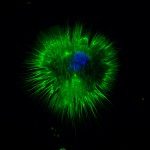Link to Pubmed [PMID] – 35438172
Link to DOI – 10.1242/dev.200104
Development 2022 Apr; 149(8):
Hofbauer cells (HBCs) are tissue macrophages of the placenta thought to be important for fetoplacental vascular development and innate immune protection. The developmental origins of HBCs remain unresolved and could implicate functional diversity of HBCs in placenta development and disease. In this study, we used flow cytometry and paternally inherited reporters to phenotype placenta macrophages and to identify fetal-derived HBCs and placenta-associated maternal macrophages in the mouse. In vivo pulse-labeling traced the ontogeny of HBCs from yolk sac-derived erythro-myeloid progenitors, with a minor contribution from fetal hematopoietic stem cells later on. Single-cell RNA-sequencing revealed transcriptional similarities between placenta macrophages and erythro-myeloid progenitor-derived fetal liver macrophages and microglia. As with other fetal tissue macrophages, HBCs were dependent on the transcription factor Pu.1, the loss-of-function of which in embryos disrupted fetoplacental labyrinth morphology, supporting a role for HBC in labyrinth angiogenesis and/or remodeling. HBC were also sensitive to Pu.1 (Spi1) haploinsufficiency, which caused an initial deficiency in the numbers of macrophages in the early mouse placenta. These results provide groundwork for future investigation into the relationship between HBC ontogeny and function in placenta pathophysiology.






